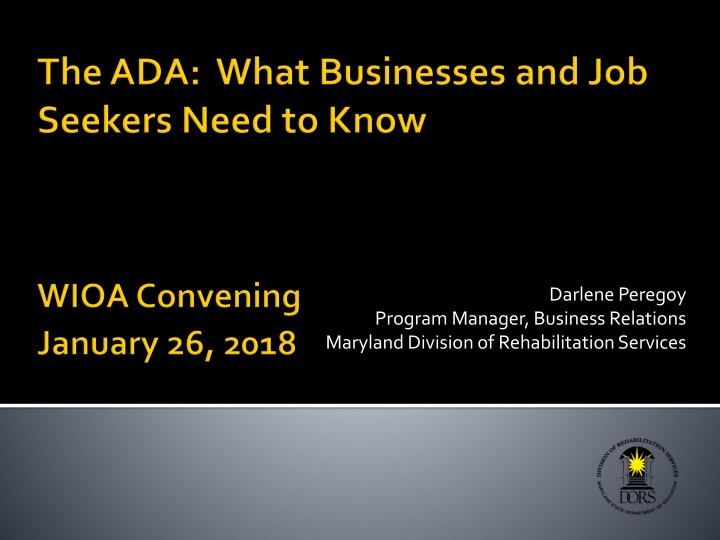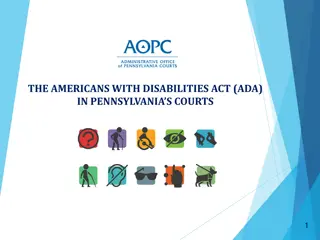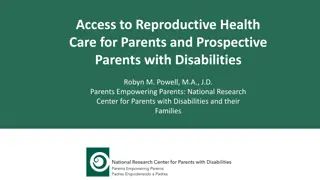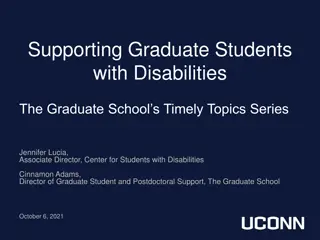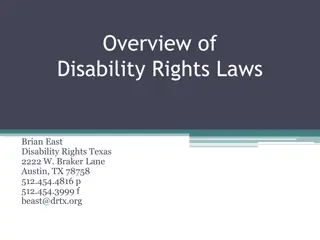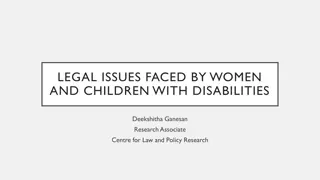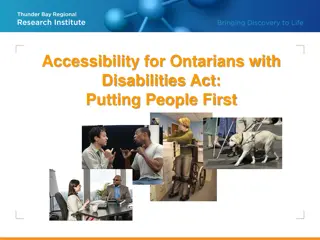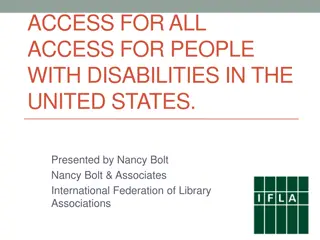The Americans with Disabilities Act
The Americans with Disabilities Act (ADA) is a Federal civil rights law signed in 1990. It provides protections to individuals with disabilities similar to those based on race, color, sex, national origin, age, and religion. The ADA covers individuals with physical or mental impairments that limit major life activities, ensuring they are treated fairly in employment and society.
Download Presentation

Please find below an Image/Link to download the presentation.
The content on the website is provided AS IS for your information and personal use only. It may not be sold, licensed, or shared on other websites without obtaining consent from the author.If you encounter any issues during the download, it is possible that the publisher has removed the file from their server.
You are allowed to download the files provided on this website for personal or commercial use, subject to the condition that they are used lawfully. All files are the property of their respective owners.
The content on the website is provided AS IS for your information and personal use only. It may not be sold, licensed, or shared on other websites without obtaining consent from the author.
E N D
Presentation Transcript
Darlene Peregoy Program Manager, Business Relations Maryland Division of Rehabilitation Services
10.4 % of Marylanders of working age (18-64) 13.9% of 18-34 year olds in higher education Baby boomers are aging Of 69.6 million, 20 million families in U.S. have at least one family member with a disability Largest minority group in the United States 3rdlargest market segment in the United States The unemployment rate for those with a disability is higher than for those with no disability
People with disabilities Represent a significant source of untapped talent (ODEP) Perform as well as other employees (DePaul University) Have educational levels similar to others (National Organization On Disability) Can be and are held to the same performance standards as any other employee (Office of Disability & Employment Policy) 4
What is the ADA? Who does it cover? Definition of Individual with Disability ADA & Employment Resources
The Americans with Disabilities Act (ADA) is a Federal civil rights law. It was signed into law by President George Bush on July 26, 1990. It gives Federal civil rights protection to individuals with disabilities similar to those provided to individuals on the basis of race, color, sex, national origin, age, and religion.
With respect to an individual, the term "disability" means: (A) a physical or mental impairment that substantially limits one or more of the major life activities of such individual; (B) a record of such an impairment; or (C) being regarded as having such an impairment.
What is a Major Life Activity? Walking Seeing Hearing Speaking Sleeping Breathing Learning Caring for oneself Working
Apparent Non-apparent Congenital Progressive Episodic Static Perceived
ADA - 1990 ADAAA - 2008
Prohibits employment discrimination on the basis of disability. The ADA protects a qualified individual with a disability from discrimination in job application procedures; hiring; advancement; discharge; compensation; job training; and other terms, conditions, and privileges of employment.
Enforced by Equal Employment Opportunity Commission (EEOC) Applies to private sector workplaces with 15 or more employees Applies to all state/local government employers Protects against disability discrimination in all employment processes Limits employer disability inquiry Reasonable accommodation unless there is undue hardship 13
The ADA Amendments Act (ADAAA) became effective on January 1, 2009. The ADAAA broadens the definition of 'disability' by modifying key terms of that definition by: expanding the definition of 'major life activities;' redefining who is 'regarded as' having a disability; modifying the regulatory definition of 'substantially limits; specifying that "disability" includes any impairment that is episodic or in remission if it would substantially limit a major life activity when active; and prohibiting consideration of the ameliorative effects of "mitigating measures" when assessing whether an impairment substantially limits a person's major life activities.
Applies to applicants or employees who: Have a disability Have a record of having a disability Are regarded as having a disability What is a disability? A physical or mental impairment that substantially limits one or more major life activities* * http://www.eeoc.gov/laws/regulations/ada_qa_final_rule.cfm 15
The hiring process must be made accessible and accommodations must be provided if requested No disability inquiry during recruitment, screening or hiring No medical inquiries or indirect questions about disability Many disabilities covered under the ADA are not apparent to others The decision to not tell about a disability during hiring is not a lie. It is a legally protected right 16
Some medical inquiry can be made after a job-offer has been extended but before employment has started Apply same medical inquiry process to all applicants in a job category (No selective inquiries) If this inquiry shows that the person has a disability, the job offer can only be withdrawn if: The withdrawal is job-related and consistent with business necessity No reasonable accommodation can be provided 17
Any change in the work environment or in the way things are customarily done that enables an individual with a disability to enjoy equal employment opportunities. * Applies to both hiring and employment Must be provided for known disabilities Determined through an interactive process Medical information can be collected related to the accommodation need and must be kept confidential ASL sign for work *(EEOC: w.eeoc.gov/policy/docs/accommodation.html) 18
Applicants, part-time employees, seasonal and temporary workers: With disabilities covered by the ADA and Who can perform the essential functions of the job with or without reasonable accommodations
Process starts when an employee says, I am having trouble performing my job because of a medical condition or disability. Employee can make the request in plain language Employer can have a formal accommodation process that the employee must follow Employer must respond to an accommodation request in a timely manner. Employer can collect medical information that supports making an accommodation decision.
The median cost of a first year job accommodation is $25. The net economic benefit in the first year of an accommodation is $11,335. Top benefits of accommodations include retention, productivity, and increased morale.
Changes in work schedules Job-aids: Reminders, checklists, or picture-based tools Changes in break times Work from home Voice-to-text software Screen readers or magnifiers Sign language interpreters (for key workplace interactions) Modified workplace policies (e.g. changing policies around drinking water at work stations) Changes in furniture or equipment Leave Job re-structuring Re-assignment to a different job ASL sign for work 22
When should someone disclose to an employer they have a disability? What are some of the issues relative to disclosure in the job search and employment? Can an employer ask?
Employers can discipline and/or terminate an employee with a disability. 25
Employers can discipline and/or terminate an an employee with a disability. 26
An employer cannot take measures to prevent a dangerous situation if this measure would impact the rights of people with disabilities. 27
Employers cannot take measures to prevent a dangerous situation if this effects the rights of people with disabilities. A credible, legitimate direct threat can trump the ADA. But this threat must be based on real evidence, not vague suppositions or ungrounded fears that something could happen. 28
An employee who is currently using drugs illegally can be terminated. 29
An employee who is currently using drugs illegally can be terminated. 30
A job applicant can be screened out if it s obvious that a disability will stand in the way of being able to do the job. 31
Applicants can be screened out if it s obvious that a disability will stand in the way of being able to do the job. The job application process must be made accessible to all who want to apply. The employer must make all aspects of the application process accessible and provide accommodations to applicants who request them. 32
The average cost of an accommodation is about $500. 33
The average cost of an accommodation is about $500.* About half of all accommodations cost nothing. *Job Accommodation Network (Updated 2011). Workplace accommodations: Low cost, high impact. http://AskJAN.org/media/LowCostHighImpact.doc 34
The right to prove themselves in the workplace and succeed on their talent and drive alone. Rep Steny Hoyer on the signing of the ADA Amendments Act in 2008) 35
Mid-Atlantic ADA Center http://www.adainfo.org/ DORS http://dors.maryland.gov/Pages/default.aspx Job Accommodation Network (JAN) https://askjan.org/ Employer Assistance and Resource Network (EARN) http://askearn.org Access for All: A Resource Manual for Meeting the Needs of One- Stop Customers with Disabilities http://www.communityinclusion.org/onestop/onestopmanual.html OFCCP Resources for Federal Contractors relating to Section 503 and VEVRAA http://www.dol.gov/ofccp/regs/compliance/resources_selfid.htm
WorkforceGPS: Disability and Employment Resource Library https://disability.workforcegps.org/resources/brow se?id=5FB2633AB9E9490BA0513DE328A5C879 Promising Practices In Achieving Universal Access and Equal Opportunity https://www.dol.gov/oasam/programs/crc/188Guid e.htm DOL Office of Disability Employment Policy (ODEP)https://www.dol.gov/odep/topics/Workforc eSystem.htm
Darlene F. Peregoy Program Manager Business Relations Branch Division of Rehabilitation Services darlene.peregoy@maryland.gov 410-554-9408
